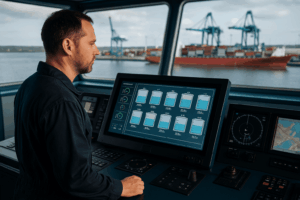Installing a tank level gauging system in Houston Port is now more important than ever. Ships carry liquids like fuel, ballast water, and drinking water. Monitoring these tanks the right way helps avoid accidents, delays, and environmental risks. A modern gauging system makes this task simple, safe, and fully automated.

These systems use sensors to measure tank levels. They send real-time data to screens in the control room. As a result, the crew always knows how much liquid is inside. No need for guesswork. No more manual checking.
At busy ports like Houston, time matters. Every second counts. With a digital system, you save time and reduce errors. Even better, many systems come with alarms. These alert you before a tank gets too full or runs too low. That’s smart safety.
Moreover, these systems often store data. This helps track usage, spot leaks early, and follow safety rules. You can even monitor everything remotely. All it takes is a smart screen or a mobile device.
Why Use It in Houston Port?
Houston Port is a high-traffic maritime hub. Because ships load and unload here often, tank management must be fast and accurate. A gauging system ensures this. It keeps your operations smooth and your crew safe.
Top Features You’ll Love
-
Real-time tank level updates
-
High-accuracy radar or ultrasonic sensors
-
Automatic overfill and low-level alarms
-
Remote monitoring and control
-
Logs for audits and compliance
If you’re upgrading your ship systems or planning a new build, choose a gauging system made for harsh marine environments. It’s one of the best safety decisions you can make.
FAQs with Answers:
1. What is a tank level gauging system?
It’s a system that measures liquid levels in shipboard tanks using sensors.
2. Why do ships at Houston Port need it?
It ensures fast, safe, and accurate tank management during loading or sailing.
3. Which tanks can it monitor?
It works for fuel, ballast water, freshwater, and wastewater tanks.
4. Does it reduce the need for manual checks?
Yes! It sends accurate readings directly to your control system.
5. Can I use it on an older ship?
Yes, most systems support retrofitting without major changes.
6. What kind of sensors are used?
Radar, pressure, and ultrasonic sensors are common.
7. Is the system safe for oil tanks?
Yes. It’s built for hazardous zones and meets marine safety rules.
8. Can I check tank levels remotely?
Absolutely. You can monitor everything from your PC or tablet.
9. What about maintenance?
Very little. Just inspect sensors every 6–12 months.
10. Does it help meet safety standards?
Yes, it supports IMO and class society compliance.


Latest Products
YDK Technologies MKN020 Gyro compass connection box
AED 3,960.0Original price was: AED 3,960.0.AED 2,850.0Current price is: AED 2,850.0.Onwa KM-8X 5-in-1 Marine Bundle Set Radome – GPS, Chartplotter, EchoSounder, AIS, Radar
8-inch GPS Chart Plotter with AIS and Radar
Onwa KM-8A (BUNDLE) 8-inch Color TFT LCD GPS Chart Plotter with Class B+ AIS Transponder MFD [BUNDLE]